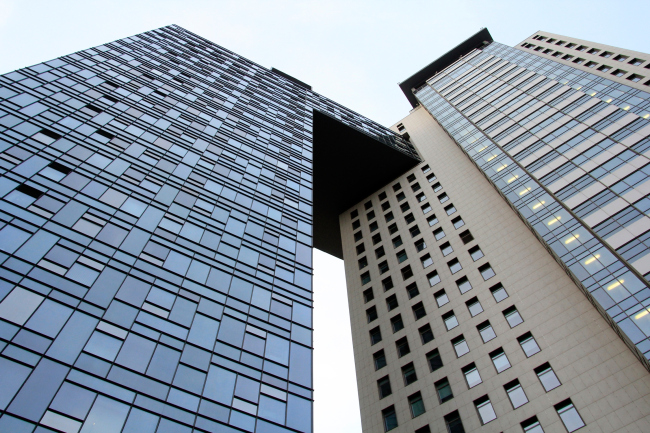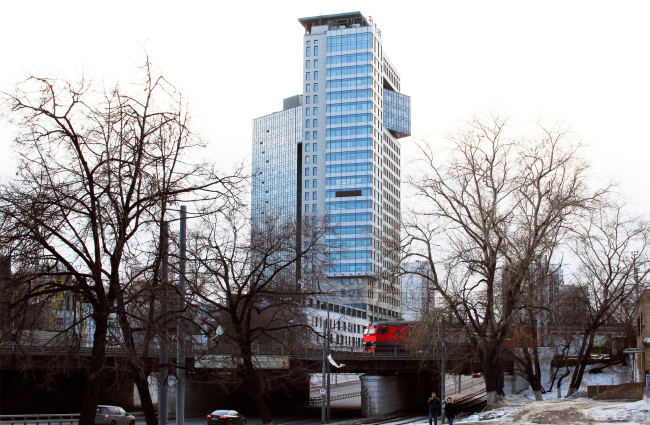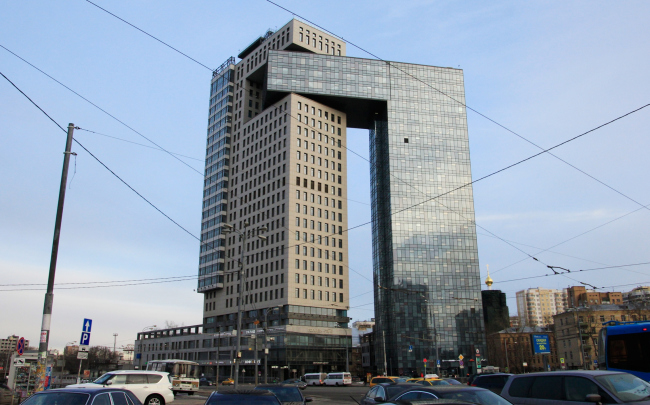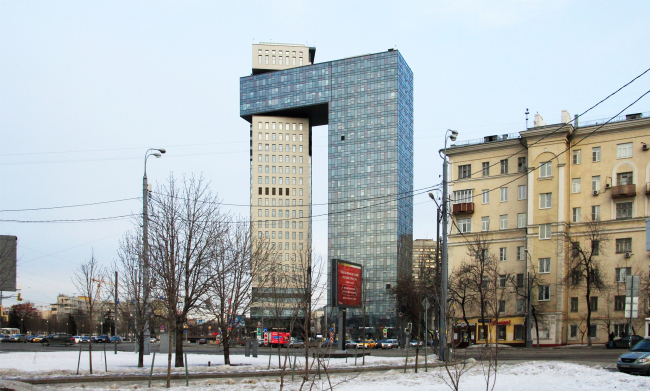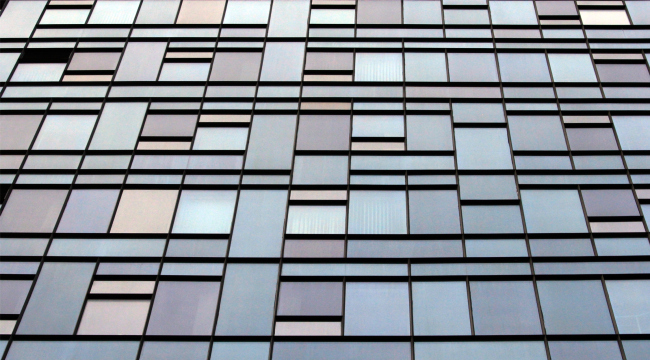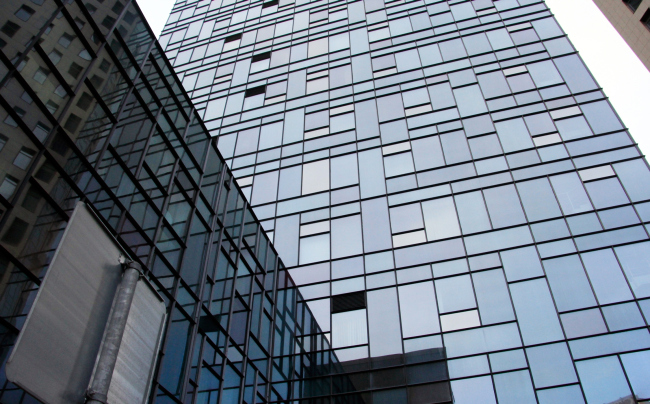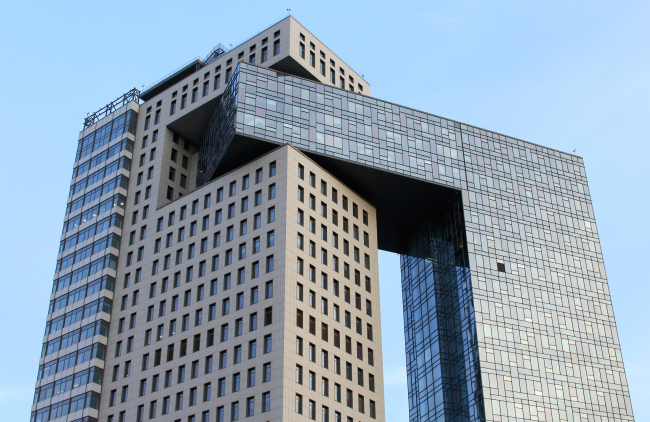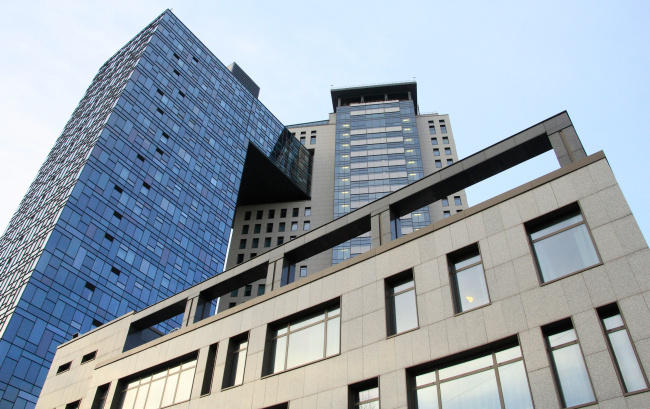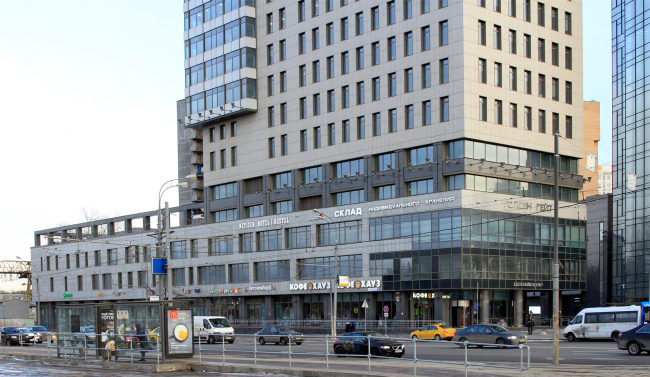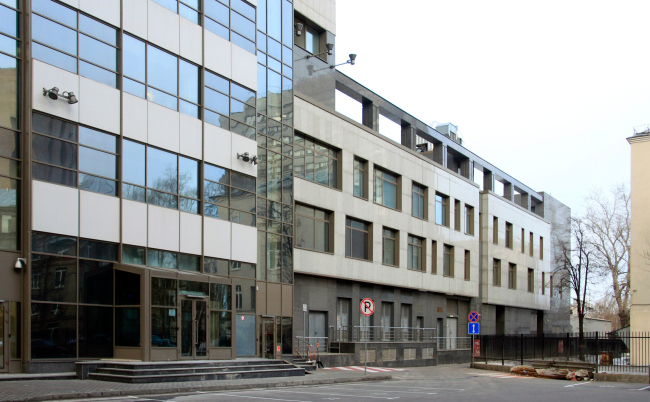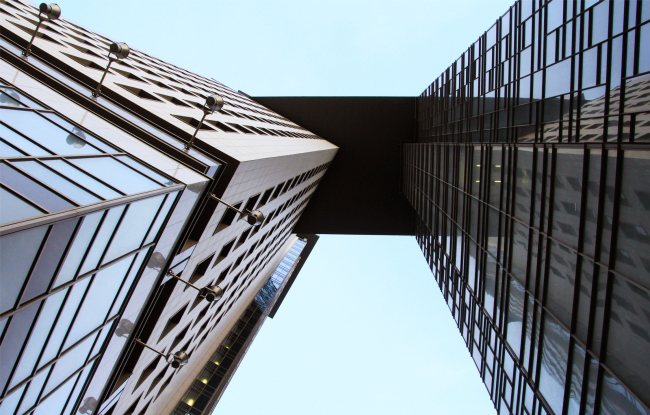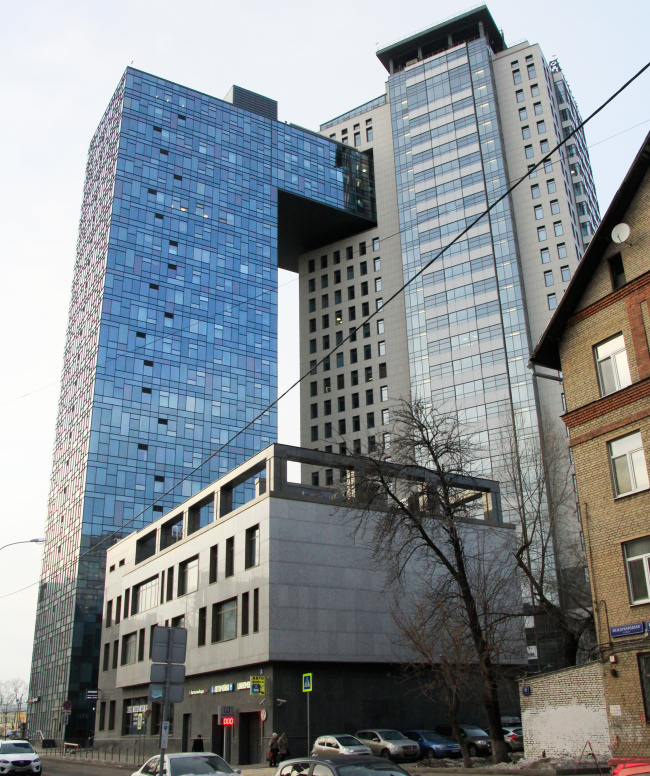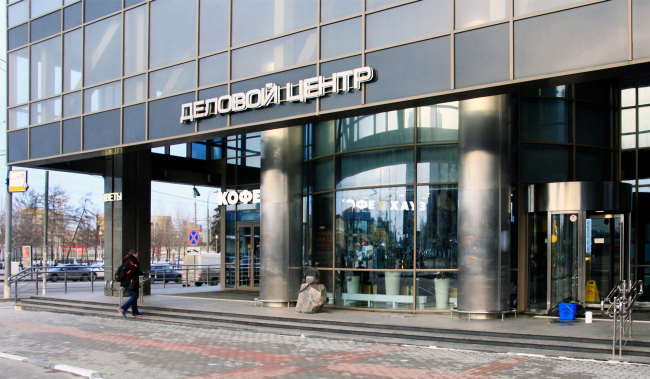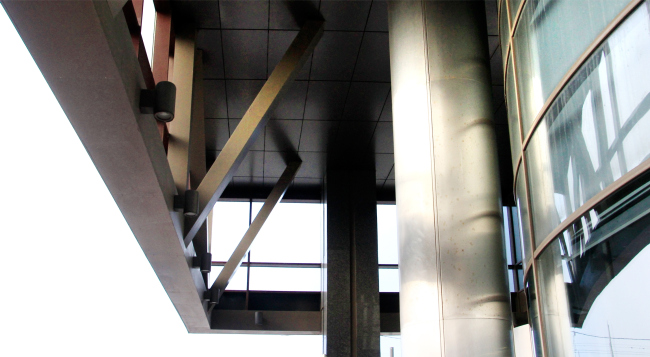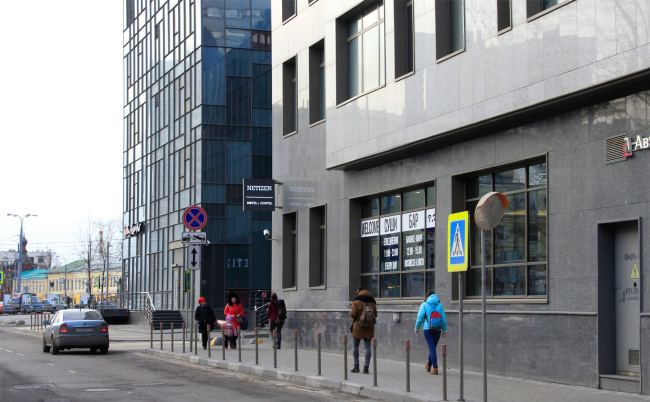|
Published on Archi.ru (https://archi.ru) |
|
| 22.01.2018 | |
|
The Vladimir Gate |
|
|
Julia Tarabarina |
|
| Architect: | |
| Pavel Andreev | |
|
The Golden Gate business center became a noticeable complement to the district of Rogozhskaya Zastava – the architects creatively revised the increase in the construction scale of this area. The mind-blowing cantilevered overpass situated at the level of the twenty-second floor is arguably the first experiment of such kind in Moscow. "Golden Gate" multifunctional complex © Pavel Andreev. Photograph © Julia Tarabarina, Archi.ruThe project of the business center at the Ploshchad Ilicha Square was already covered by us in 2007. It was completed in 2014, and for several years already it has been serving as the landmark of this square, clearly visible from a distance: from the point on the Garden Ring before the Yauza Bridge, from the crossing of the Entuziastov Highway and the Third Transport Ring, from the bridge of the Kurskaya Railroad, from the Sergeya Radonezhskogo Street, and in the historical perspective of the Shkolnaya Street. Generally speaking, the architects have definitely been able to implement the main themes of the project – so indivisible was the concept of the open city gate executed in the form of a pivotal connection between two different but equally sized slabs, standing at an angle to each other, with an overpass connecting them at the top. “The Vladimir road used to lie where now the Shkolnaya Street is; this is its historic route. Here, on this square, it crossed with the Kamer-Kollezhsky Val – Pavel Andreev shares – There are no “vals” (which translates as “ramparts”) any longer, memories of them only remaining in the names of the local streets, and there is no “zastava” (which literally translates as “city gate”) – there is only a square that bears that name. This is why we allowed ourselves to call our project “Vladimirskie Vorota” (“Vladimir Gate”), and treat this building, well, not in the most literal sense, rather conditionally, but still as a gate, a part of the city border. Then the owners renamed it to become “Golden Gate” by analogy with the “Golden Gate”, which stands for the Kremlin in the city of Vladimir – a posh commercial spin, really. As for our idea, however, it was more of a town-planning character: what we wanted to do was to give back to this place its historical symbol, reviving it on a modern scale”. "Golden Gate" multifunctional complex © Pavel Andreev. Photograph © Julia Tarabarina, Archi.ru"Golden Gate" multifunctional complex © Pavel Andreev. Photograph © Julia Tarabarina, Archi.ru"Golden Gate" multifunctional complex © Pavel Andreev. Photograph © Julia Tarabarina, Archi.ru"Golden Gate" multifunctional complex © Pavel Andreev. Photograph © Julia Tarabarina, Archi.ruThe gate that opens up the road which leads to the city of Vladimir is, of course, a general image that was borrowed not so much from the historical reality as from the town-planning situation. In fact, the Rogozhskaya Zastava was vastly different: built in the late XVIII century, it consisted of two low-rise corps de gardes or “guardhouses” with arched galleries and obelisks – the inevitable parts of the city boundaries built in the times of Catherine the Great. 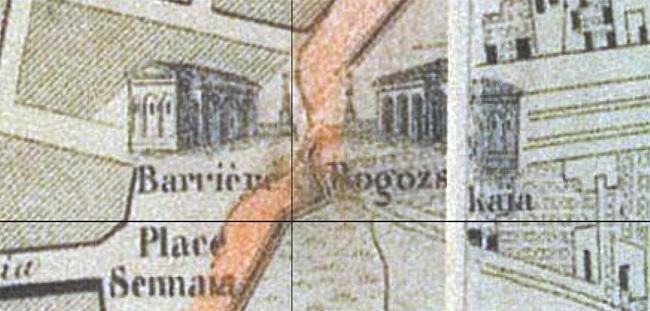 Rogozhskie Vorota. Fragment of the "Nouveau plan de Moscou illustre" ("New Illustrated Plan of Moscow") published by Daziaro, M, 1852 / Rogozhskaya Zastava, XIX century.The Zastava consisted in fact if two squares: what is now known as Shkolnaya Ulitsa would lead, back in those days, to the still older Sennaya Ulitsa, which actually was “strung” on the old Vladimir Square, while the neighboring Rogozhskaya Zastava Square was comparatively new. Today, both squares merged into one and then disappeared, swallowed by the road junction overlooking the railroad bridge and surrounded from one side by old-Moscow two-story houses, and from the other side – by prefabricated 12-story houses built back in the 1980’s, the latest reiteration of the great construction boom of the early heroic years; although standard, these houses stand along the “red” construction line, and they surprisingly have porches in front of them, which are obviously meant to pay homage to other buildings of this area and decrease the perception scale of these 12-story things. In a word, this place is highly contrastive; several epochs and town-planning trends come together here. The business center designed by Pavel Andreev made the most out of this contrast. Two towers: one 26 stories high with a half-story of technical rooms, coated with light-pale ceramic granite, is subjugated to the strict pattern of moderately vertical windows and is stretched along the Entuziastov Highway, thus belonging to the road leading out of town. The pattern of the windows and the color of the façade echo the neighboring Stalin house, which is #2 on the Rogozhsky Val – although the tower is three and a half times as tall, it still continues the line of the street by picking up the rhythm but making it clearer and denser. This is particularly visible from the beginning of the Shkolnaya Ulitsa. "Golden Gate" multifunctional complex © Pavel Andreev. Photograph © Julia Tarabarina, Archi.ruThe second tower has 24 stories in it; all of its façades are covered in blacked out glass of different shades and transparency: this technique was earlier used by “Ostozhenka” in designing the “Panorama” residential project. However, great as it is, this technique, helps to turn the tower into a solid slab of dark glass: it grows up from the bottom floor without so much as a hint at a basement: here you’ve got the pavement stones, and there is glass staring you right in the face. The idea consisted in masking all the intermediate floors by making the second tower look like a completely single whole to the point of being slightly unreal and ostentatiously modern – and this attempt was a success. Although it was originally planned that the glass tower was to be darker, and although it was planned that it would be a hotel, now both of the volumes are occupied by the offices of the business center. One must admit that the original idea was slightly more on the rugged side, yet it looked more detailed because of the hi-tech antennas near the south façade. Now, however, it is a solid prism that looks like it was chiseled from some dark-water iceberg.Of course, if one really feels like counting the floors, he can do it but he will have to look really hard: the volume is really solid, and at the same time colorful; besides, it quickly reacts to changes in the ambient light, constantly shifting its shades, which looks particularly great at sunset because its main façade is the west one. "Golden Gate" multifunctional complex © Pavel Andreev. Photograph © Julia Tarabarina, Archi.ru"Golden Gate" multifunctional complex © Pavel Andreev. Photograph © Julia Tarabarina, Archi.ruThe glass tower is stretched along the Rogozhsky Val Street, and it follows its curve; what it ends up being is some sort of a reshuffle – the volume with windows, designed in a more traditional way, “spills over the town”, while the more modern one marks the city’s historical boundary. The gate turned out to be quite convincing, the only difference being that it stands on one side of the highway and, come right down to it, looks more like one open wing of the gate. But it is even more interesting that way. The most striking architectural gesture is the cantilevered overpass whose glass volume barges into the neighboring tower at the height of the 22-24th floors; it is even mentioned at the business center’s website, which is a relatively rare thing by Moscow standards. Looking from the inside of the overpass, one will be able to see the zigzag of the truss added in order to strengthen the structure: initially it was not planned to be there, and the “camouflage” pattern of the glass façade is partially explained by the desire to hide the silhouette of the truss. "Golden Gate" multifunctional complex © Pavel Andreev. Photograph © Julia Tarabarina, Archi.ru"Golden Gate" multifunctional complex © Pavel Andreev. Photograph © Julia Tarabarina, Archi.ru"Golden Gate" multifunctional complex © Pavel Andreev. Photograph © Julia Tarabarina, Archi.ruThe crossing of the elements accentuates the turning angle and draws one’s attention to the large form helping the building to fit in with the scale of the new city: yes, this is a borderline place but the city keeps growing – soon, slightly to the east, the buildings of the “Symbol” housing project will be completed in the stead of the former “Serp i Molot” plant, and then the overall height of the area (which now looks pretty diverse) will surely increase. Meanwhile, the business center “picks up” this very theme of “height diversity” of this area, adding two towers, so effectively linked with each other by volumes of smaller scale – a five and a four-story one. The former continues the light tower standing along the Entuziastov Highway, the arch of the latter joins the glass high-rise from the side of the Mezhdunarodnaya Street; it hosts the 2-star hostel Netizen that is a hit with its numerous guests. Both wings do not imitate the historical construction and do not try to either present a semblance of “Dutch houses” or even imitate the style of the Shkolnaya Street. Technically, their façades are designed just about in the same way as the first tower – from ceramic granite. Looking at them, one can even feel an element of deconstruction: there is a large see-through grille towering above each of the buildings, as if the top floor was dismantled but its framework was left to stay there. "Golden Gate" multifunctional complex © Pavel Andreev. Photograph © Julia Tarabarina, Archi.ru"Golden Gate" multifunctional complex © Pavel Andreev. Photograph © Julia Tarabarina, Archi.ru"Golden Gate" multifunctional complex © Pavel Andreev. Photograph © Julia Tarabarina, Archi.ru"Golden Gate" multifunctional complex © Pavel Andreev. Photograph © Julia Tarabarina, Archi.ru"Golden Gate" multifunctional complex © Pavel Andreev. Photograph © Julia Tarabarina, Archi.ruThe volumes veer off eastward like a pair of scissors, forming a small trapeze-shaped yard, rather empty but still open to the general public; one can traverse it, first passing beneath the minor link in front of the hotel, and then marveling at the high overpass between the towers. "Golden Gate" multifunctional complex © Pavel Andreev. Photograph © Julia Tarabarina, Archi.ruAnd, while the minor volume, which stands next to the highway, does not mimic the neighboring buildings but, rather, forms five-story construction front side, the hotel, which stands on the Mezhdunarodnaya Street, continues the lineup of the neighboring buildings – rather curious-looking silicate brick five-stories with a square plan and a double-pitch roof, unusual for Moscow (MG-2 series, mid-1950’s). The Mezhdunarodnaya Street remained low-rise and cozy; it even looks as if it was “hidden” behind the shield of the glass tower. Thus, the business center, which definitely belongs with the future in many ways, grows from the past, belonging at the same time with its surroundings, trying to tie in the former and the latter. In this sense, it is the inheritor of the idea that once gave birth to the panel houses which stand along the Sergeya Radonezhskogo Street, an attempt to tie in two different scales and completely different times, show respect to different types of construction and make them “make peace” with each other. "Golden Gate" multifunctional complex © Pavel Andreev. Photograph © Julia Tarabarina, Archi.ruWalking around the complex is a rather pleasant thing to do, although there isn’t any “green” landscaping around it, just paving stones. But the abundance of cafes and other businesses that populated the bottom floors is doing its job turning the small square behind and in front of the towers into a cozy little place. The impressions are strengthened by round metallic supports placed within the contour of the glass façade – the “casing” of the tower in front of the main entrance – as if the shell of the 26-story building suddenly lifted itself up in the air giving the visitors an opportunity to come inside. "Golden Gate" multifunctional complex © Pavel Andreev. Photograph © Julia Tarabarina, Archi.ru"Golden Gate" multifunctional complex © Pavel Andreev. Photograph © Julia Tarabarina, Archi.ru"Golden Gate" multifunctional complex © Pavel Andreev. Photograph © Julia Tarabarina, Archi.ru"Golden Gate" multifunctional complex © Pavel Andreev. Photograph © Julia Tarabarina, Archi.ruAs for the underground structure of this complex, it is rather sophisticated. Both towers rest on the lobbies of the “Rimskaya” metro station; it neighbors on the complex’s parking lot (it must be said that because of the communication difficulties the parking lot was made partially overland). In addition, Pavel Andreev, the architect who likes his projects to unobtrusively fit in with the city not only in terms of their plastique and theme but also from the technical standpoint, insisted that the engineering lines of the complex be routed to an underground collector, which could be later extended by connecting the neighboring buildings to it. Alas, the initiative did not get much support: in particular, “Symbol” opted out of getting connected to this collector, and the system remained on paper. Which, incidentally, does not by any means devalue the architects’ attempt “to do the right thing” that they tried to make in the “Golden Gate” project: possibly, those who will come after them will use this resource one day. |
|


